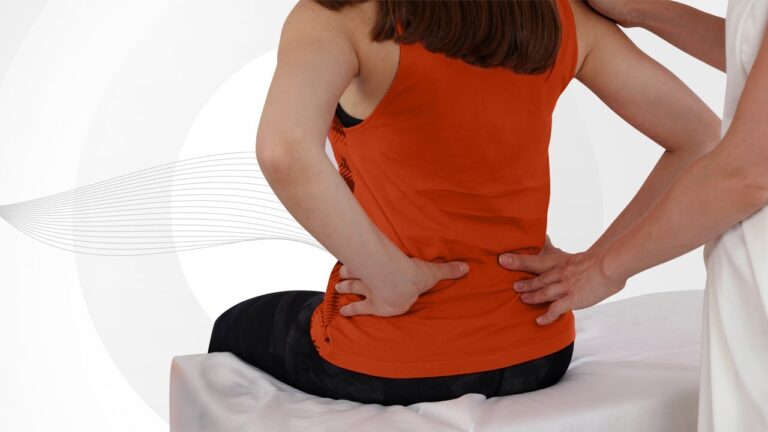Discs between each of the 26 vertebrae, or bones, make up your spine. These discs serve as cushions for your spine and are composed of a jelly-like substance.
When a disc’s entirety or a portion of it is driven through a vulnerable area of the spine, it becomes herniated (or slid). The spinal cord or surrounding nerves may be compressed as a result. Pain, numbness, and weakness are signs of an upper back herniated disc, also known as a thoracic herniated disc.
The following are some typical signs of a herniated or slipped disc :
- A physical ailment that only affects one side.
- Numbness in some areas of the leg, hip, or buttocks and sharp pain in others. The sole of your foot or the back of your calf may also be painful or numb. Sometimes the same leg will feel weak. The majority of the time, these are symptoms of a slipped disc in the lower region of the spine.
- Deep discomfort around or over the shoulder blade, pain when moving your neck, etc. Moreover, you can experience numbness throughout your shoulder, elbow, forearm, and fingers as well as pain that radiates to your upper arm, forearm, and fingers. These are frequent signs of a slipped disc in the neck.
A slipping disc’s discomfort frequently seems worse :
- Right after standing or seated
- At night
- When laughing, hiccupping, or sniffling
- Whether stopping or moving more than a few feet

DISC PAIN IN THE THORACIC REGION
The mid-back vertebrae are supported and cushioned by 12 intervertebral discs in the thoracic spine. 1 The nucleus pulposus, a jelly-like inner core, bulges or becomes extruded when the disc’s strong outer covering (annulus fibrosus) rips.
A thoracic herniated disc can cause a variety of pains, including :
- Discogenic discomfort:- Back pain may concentrate at the site of the injury due to an annulus fibrosis rupture or tear and surrounding disc connective tissue inflammation. This discomfort could be mistaken for stomach, lung, or cardiac pain.
- Muscular spasm:- Localized lesions to the supporting ligaments and intervertebral discs may cause the surrounding muscles to contract defensively. The big muscles in the back have a tendency to contract and eventually spasm. Muscle spasms can cause pain that spreads across several levels of the back, limit motion, or make it difficult to stand up straight.
- Ache in the radicle:- The nerves innervating the chest wall around the ribs and abdomen may be compressed or irritated by a herniated thoracic disc with a lateral component. Although it often feels achy or mild, this pain is usually unilateral and reported as scorching or electric shock-like. This discomfort occasionally resembles a ring around the chest or abdomen.
WEAKNESS AND NUMBNESS BROUGHT ON BY A HERNIATED THORACIC DISC
Although they are uncommon, neurological impairments caused by a thoracic herniated disc can be significant.
Radiculopathy of the thorax
Thoracic radiculopathy can be brought on by a thoracic herniated disc that pushes or irritates a nearby nerve root when it branches off the spinal cord and leaves the central canal. Tingling, numbness, and/or pain that radiates into the chest or belly are symptoms of thoracic radiculopathy.
Chest myelopathy
Thoracic myelopathy is a condition where the spinal cord is compressed by a herniated thoracic disc. Potential symptoms include weakness in the legs and/or tingling and numbness anyplace at or below the area of the ruptured disc. The progression of myelopathy may cause issues with balance, walking, spasticity, feeling in the saddle area, and/or bowel and bladder difficulties.
Pain from a herniated thoracic disc normally goes away after 6 to 12 weeks of nonsurgical treatment. Even unilateral radiculopathies can frequently be treated non-surgically. Any new or developing neurological abnormalities that cause radiating pain, numbness, weakness, unsteadiness in gait, or bowel or bladder dysfunction must be treated right away by a doctor.

PREVENTION
Do the following to help prevent a herniated disc :
- Exercise:- By making the trunk muscles stronger, the spine is stabilized and supported.
- Keep a straight spine:- Your spine and discs are under less pressure as a result. Maintain a straight and aligned back, especially when sitting for extended periods of time. Raise large objects correctly, putting most of the weight on your legs rather than your back.
- Keep a healthy weight:- More weight puts extra strain on the discs and spine, increasing the risk of herniation.
Give up smoking:- Don’t use any tobacco products at all.
Call the Specialty Care Clinics to make an appointment at (469) 545-9983 if you have thoracic herniated disc discomfort and would want to learn more about it.
